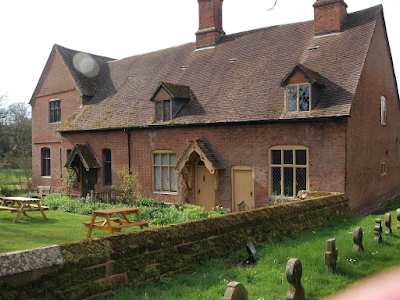 |
| MEDIEVAL ORIGINS: The Old Hall was built during the heyday of the renowned Knights Templar |
HARD to believe today, but this quaint-looking cottage in the Solihull countryside was once the local headquarters for an ancient order of warrior monks.
The Old Hall, at Temple Balsall, was previously at the heart of the preceptory (command centre) for the Knights Templar in Warwickshire.
The building's name isn't an empty boast either, tests of the roof timbers have revealed the frame dates back perhaps as far as the 1200s.
It was beneath these beams that one of the most fearsome fighting companies in Christendom conducted their business, before their dramatic fall from grace in the early 14th century.
 |
| OUTSIDE: The neat cottage garden. The parish church is visible behind. |
But behind the work of Sir George Gilbert Scott, a prolific architect, is a much older Medieval structure. Although largely hidden today, it survived the more recent modifications.
When experts decide on the importance of any particular building, they consider not only its age or what it looks like but the history around it.
This has a number of different strands. First there is the fact that somewhere was, in the past, linked to a particular group or activity or person.
Sometimes these connections are rather flimsy; think how many coastal pubs in this country claim to be former smugglers' havens or the number of old estates insisting that a particular King or Queen got some kip there many moons ago.
The Old Hall has, by contrast, copper-bottomed ties to the Templars, who were gifted the land by a wealthy admirer and ally.
The history of the site is fairly well documented, the very name of the hamlet today derives from the order which once held sway over some 640 acres of arable land.
Historian Eileen Golder, who has written extensively about the estate, paints a picture of a thriving farming community. She describes how sheep were fattened here, apples pressed for cider and how the country landscape would have even been enlivened by exotic peacocks.
As Golder notes Balsall, with "its space and seclusion and reasonably central position" had much to recommend it.
It was the abundance of agricultural activity, here and at similar sites elsewhere, that allowed the order to raise funds for the religious crusades it engaged with overseas.
Amid the milling and ploughing and animal breeding was the Old Hall, which appeared to become an important site for welcoming new recruits and meting out punishments to those in the order who fell foul of its strict moral codes.
If past events are one part of heritage, actual objects associated with them are another. The archaeological importance of Temple Balsall is why a wider area around the Old Hall is actually marked out as a legally protected "scheduled monument".
In the 1980s, the property's cellar was excavated and while the finds were much later than the Middle Ages - consisting mostly of pottery from the hall's 17th century period - it is proof that physical artefacts can and do get unearthed.
What else may lie undiscovered is something we might explore as we visit other buildings in this still deeply rural part of the borough in future posts.
Knights Templar: The military order was set up in 1119 and several decades later, during the reign of King Stephen, acquired land at Temple Balsall.
This was a gift from the nobleman Roger de Mowbray and by the early 13th century the estate was firmly established as the local preceptory.
For another 100 years the Old Hall and the land around it was an important asset for a group who Temple Balsall's one-time vicar, Reverend R.F Fairburn, had described as "soldier-monks".
The fact he was writing about their local links almost a century ago shows the Templars have long been the subject of interest and intrigue.
Although his account, first published in 1927, perhaps centres rather more on the chivalry of the age and less on the crusades' often bloody legacy.
Aside from being a monastic order the Templars were after all a formidable force in the religious wars which wracked the Middle East throughout the Medieval era, often described as "shock troops" or the protectors of pilgrims on their way to the Holy Land.
But the Templars' fearsome reputation failed to prevent the rapid unravelling of the order in the early 1300s. Dark rumours about some of their ceremonies and a French king keen to contrive a way to discharge his deepening debt sealed their fate. Friday 13th, 1307 saw the arrest, torture and execution of many members. And five years later the Pope disbanded the order altogether.
References:
A brief history of Temple Balsall from the Foundation of Lady Katherine Leveson
Historic England Heritage List for England listing (1952)
Temple Balsall 1150-1870: A Short History, Eileen Golder (2002)
The Knights of the Temple ... and their connection with Temple Balsall, F.R Fairburn (1927)
The Templars History & Myth, Michael Haag (2009).







